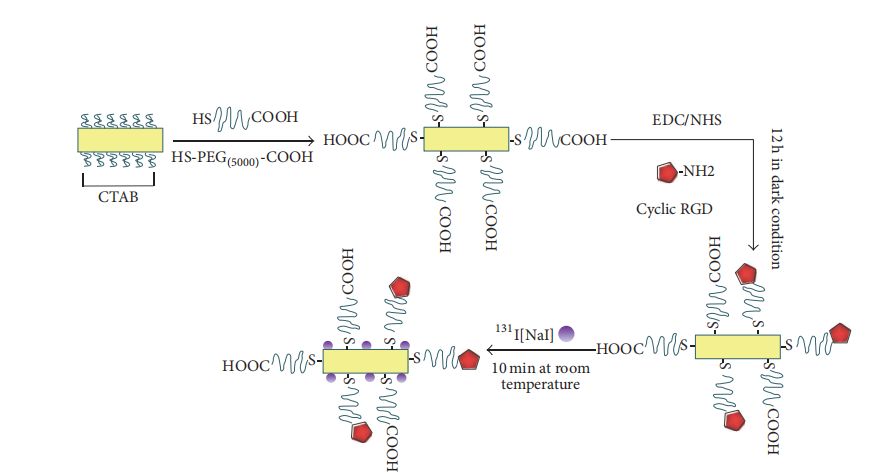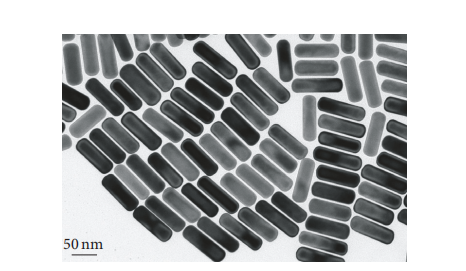文献:Synthesis and Bioevaluation of Iodine-131 Directly Labeled Cyclic RGD-PEGylated Gold Nanorods for Tumor-Targeted Imaging
文献链接:https://pubmed.ncbi.nlm.nih.gov/29434531/
作者:Yingying Zhang,Yongxue Zhang,Lianglan Yin,Xiaotian Xia,Fan Hu,QingYao Liu,Chunxia
Qin,and Xiaoli Lan
相关产品:GNR-PEG 金纳米棒-聚乙二醇
原文摘要:Radiolabeled gold nanoparticles play an important role in biomedical application.The aim of this study was to prepare iodine-131 (131I)-labeled gold nanorods (GNRs) conjugated with cyclic RGD and evaluate its biological characteristics for targeted imaging of integrin expressing tumors. Methods. HS-PEG(5000)-COOH molecules were applied to replace CTAB covering the surface of bare GNRs for better biocompatibility, and c(RGDfK) peptides were conjugated onto the carboxyl terminal of GNRPEG-COOH via EDC/NHS coupling reactions. The nanoconjugate was characterized, and 131I was directly tagged on the surface of GNRs via AuI bonds for SPECT/CT imaging. We preliminarily studied the characteristics of the probe and its feasibility for tumortargeting SPECT/CT imaging. Results. The [ 131I]GNR-PEG-cRGD probe was prepared in a simple and rapid manner and was stable in both PBS and fetal bovine serum. It targeted selectively and could be taken up by tumor cells mainly via integrin receptormediated endocytosis. In vivo imaging, biodistribution, and autoradiography results showed
evident tumor uptake in integrin expressing tumors. Conclusions. These promising results showed that this smart nanoprobe can be used for angiogenesis-targeted SPECT/CT imaging. Furthermore, the nanoprobe possesses a remarkable capacity for highly efficient photothermal conversion in the near-infrared region, suggesting its potential as a multifunctional theranostic agent.
GNR-PEG(金纳米棒-聚乙二醇)具备良好的稳定性。聚乙二醇的修饰使得金纳米棒不易聚集,能在各种环境中保持稳定的形态。其次,具有生物相容性。降低了对生物体的不良反应。再者,增强了水溶性,便于在生物体系中进行应用和传输。它还拥有光学特性,可用于生物成像等领域,在近红外光区有吸收和散射,能实现高光热转换,可进行功能化修饰,能结合特定的生物分子。研究的目的是制备与环状RGD偶联的碘-131(131I)标记的金纳米棒(GNRs)。以下是制备过程:

图:[ 131I]GNR-PEG-cRGD制备程序
GNR-PEG-cRGD的合成。
将EDC⋅盐酸和NHS分别溶解在超纯去离子(DI)水中,加入GNR-PEG溶液中,在室温黑暗中反应过夜。随后,在反应混合物中加入(RGDfK)肽,然后在室温黑暗中搅拌。在反应过程中不连续进行,以避免形成沉淀或聚集体。最终产物通过离心纯化,在去离子水中重新分散,黑暗保存。使用前进行放射性标记。将[ 131I]NaI(1111 MBq/mL)加入GNR-PEG-cRGD溶液中,在室温下反应,然后离心再分散在磷酸盐缓冲盐水(PBS)中。

图:GNR-PEG的透射电镜。
结论:GNR-PEG参与制备的[ 131I]GNR-PEG-cRGD探针的制备方法简单、快速,在PBS和胎牛血清中均保持稳定。它选择性靶向,可通过整合素受体介导的内吞作用被tumor细胞吸收。体内成像、生物分布和放射自显影结果显示,其有明显的tumor摄取。这些有希望的结果表明,这种智能纳米探针可用于生成靶向的方面/CT成像。

 2025-02-10 作者:ZJ 来源:
2025-02-10 作者:ZJ 来源:

